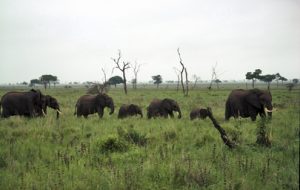– Matthew Kronborg, UNAA Executive Director

 Without a healthy environment, our global societies and economies will come under increased pressure and potentially eventually falter. We have seen a growing number of localized examples of this in recent years; for instance the Mexico ‘Tortilla Riots’ of 2007 or the 2008 Tunisian ‘Arab Spring’ uprising. In both cases, unprecedented prolonged droughts contributed to a sharp rise in local grain prices, which in turn caused a rapid rise in staple food prices, which were triggers for major civil unrest. All people are increasingly understanding of the potential consequences of unrestrained exponential emissions and in signing the Paris Climate Change Agreement in April 2016, all countries have taken another significant step in the journey to addressing this major issue. In protecting our life-sustaining environment, we must also consider the wildlife that inhabits it and the value it brings.
Without a healthy environment, our global societies and economies will come under increased pressure and potentially eventually falter. We have seen a growing number of localized examples of this in recent years; for instance the Mexico ‘Tortilla Riots’ of 2007 or the 2008 Tunisian ‘Arab Spring’ uprising. In both cases, unprecedented prolonged droughts contributed to a sharp rise in local grain prices, which in turn caused a rapid rise in staple food prices, which were triggers for major civil unrest. All people are increasingly understanding of the potential consequences of unrestrained exponential emissions and in signing the Paris Climate Change Agreement in April 2016, all countries have taken another significant step in the journey to addressing this major issue. In protecting our life-sustaining environment, we must also consider the wildlife that inhabits it and the value it brings.
This year the theme for UN World Environment Day (WED) on 5 June, is to ‘raise awareness of the fight against the illegal trade in wildlife’, and to spread the word about the damage it causes. Following on from World Wildlife Day on March 3, the WED theme, ‘Go Wild for Life’ encourages action against poachers and traffickers, as well as those who purchase their goods.
Growing demand for illicit wildlife products has lead to the disappearance of species and eroding biodiversity while undermining economies, communities, and security. Global wildlife populations have reduced by over half in the past 40 years. Rhino poaching in South Africa has increased as much as 8,000 per cent between 2007 and 2014. The Pangolin population, a creature little known by the general public but prized for the alleged medicinal value of its scales, meat, and blood, is the most trafficked mammal in the world, with over a million taken from the wild in the past decade. Tiger numbers have also drastically decreased, from over 100, 000 a century ago, to fewer than 3, 000 today. The rate at which African elephants are poached means that they could become extinct within the next two decades. There are few good news stories when it comes to global wildlife populations.With an estimated annual value of over $20 billion USD and with activities involving cross-border criminal networks, it comes as no surprise, that that the lucrative business of poaching and smuggling is notoriously difficult to fight.
With an estimated annual value of over $20 billion USD and with activities involving cross-border criminal networks, it comes as no surprise, that that the lucrative business of poaching and smuggling is notoriously difficult to fight.
Interest in breaking these illegal markets and preserving wildlife is slowly increasing as a global issue. In 2015, targets to end poaching were included in the Sustainable Development Goals, and the UN General Assembly unanimously agreed on a resolution to reduce unlawful trafficking in wildlife. The Convention on International Trade in Endangered Species of Wild Fauna and Flora (CITES), has committed to reviewing the National Ivory Action Plans of 19 countries, while cooperation of national enforcement agencies have successfully enabled mass-prosecution and seizure of illegally sourced wildlife products. In May 2015, the biggest ever coordinated international law enforcement operation targeting the illegal trade in endangered species named Operation Cobra III lead to the arrest of 139 people the seizure of 247 shipments.
UN Secretary-General Ban Ki-moon has commended these efforts and encouraged action to reduce both the demand and supply of illegal wildlife products through agreed goals and targets as well as the formation of international instruments. Many individual nations and regional groups are rising to the challenge. The European Union has developed an action plan with 32 concrete measures centered around prevention, reducing supply and demand of illicit wildlife products, strengthening existing rules against organized crime and enhancing inter-country cooperation. In China, where the increasing middle class has arguably been the main catalyst behind increases in the poached ivory trade, President Xi Jinping pledged to enact bans on ivory imports and exports. Other alliances such as the Giant’s Club Summit bring together African heads of state, business leaders and conservationists as a formidable and determined force against African elephant poaching.
Moral and environmental reasons aside, the preservation of wildlife also offers long-term economic value. In April 2016, Kenyan President Uhuru Kenyatta held the largest ivory burn in history, and Kenyan authorities used the hashtag #worthmorealive, to highlight that greater intrinsic value and tourism dollars are held in the live animals rather than their tusks. Mr. Kenyatta noted, “A time has come when we must take a stand, and the stand is clear … Kenya is making a statement that, for us, ivory is worthless unless it is on our elephants.” At the occasion, 105 tonnes of illegally poached tusks were set alight at Nairobi National Park, representing approximately 8000 elephants and 343 rhinos.
Zero poaching is possible. On May 2, 2016, Nepal celebrated two consecutive years since its most recent rhino-poaching occurrence. This achievement is said to be the result of a well-coordinated national response including high-level political will, as well as the collaboration of government entities and conservation communities. In addition to greater on the ground protection of Nepalese national parks, rangers employed new software and technology systems to identify poaching hot spots, improve rapid response measures and to analyse the impact of anti-poaching efforts. This is the culmination of a united national conservation success that now means 645 one-horned rhinos currently live in Nepal, the highest number ever on record.Nepal’s example of success can become a norm from which we learn. Zero tolerance must translate to zero poaching. As CITES Secretary-General, John E. Scanlon noted, “The current wildlife crisis is not a natural phenomenon – unlike a drought, a flood or a cyclone. It is the direct result of people’s actions. People are the cause of this serious threat to wildlife and people must be the solution.’
Nepal’s example of success can become a norm from which we learn. Zero tolerance must translate to zero poaching. As CITES Secretary-General, John E. Scanlon noted, “The current wildlife crisis is not a natural phenomenon – unlike a drought, a flood or a cyclone. It is the direct result of people’s actions. People are the cause of this serious threat to wildlife and people must be the solution.’